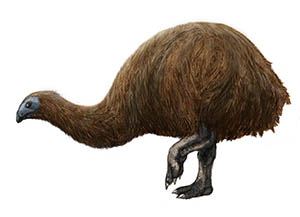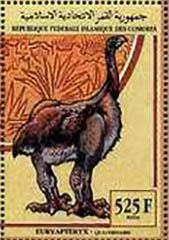Euryapteryx curtus Owen, 1846

(Da: it.wikipedia.org)
Phylum: Chordata Haeckel, 1874
Subphylum: Vertebrata Cuvier, 1812
Classe: Aves Linnaeus, 1758
Ordine: Dinornithiformes Bonaparte, 1853
Famiglia: Dinornithidae Bonaparte, 1853
Genere: Euryapteryx Haast, 1874
Italiano: Moa beccocorto settentrionale
English: Broad-billed moa
Español: Moa costero
Descrizione
Come gli altri moa, era un erbivoro che si nutriva di foglie, germogli e frutti. Tendeva più degli altri moa a frequentare gli spazi aperti.
Diffusione
Questa specie era abbastanza comune nel suo areale nell'Isola del Nord, in Nuova Zelanda.
Bibliografia
–Bunce, Michael; Worthy, Trevor H.; Phillips, Matthew J.; Holdaway, Richard N.; Willerslev, Eske; Haile, James; Shapiro, Beth; Scofield, R. Paul; Drummond, Alexei; Kamp, Peter J. J.; Cooper, Alan (8 December 2009). "The evolutionary history of the extinct ratite moa and New Zealand Neogene paleogeography" (PDF). Proceedings of the National Academy of Sciences of the United States of America. 106 (49): 20646-20651.
–Davies, S. J. J. F. (2003). "Moas". In Hutchins, Michael (ed.). Grzimek's Animal Life Encyclopedia. 8: Birds I: Tinamous and Ratites to Hoatzins (2nd ed.). Farmington Hills, MI: Gale Group. ISBN 0-7876-5784-0.
–Gill, B. J. (2010). "Regional comparisons of the thickness of moa eggshell fragments (Aves: Dinornithiformes)". Records of the Australian Museum. 62: 115-122.
–Owen, R. (1846). A History of British Fossil Mammals and Birds. London, UK: John Van Voorst.
–Worthy, T. H.; Scofield, R. P. (2012). "Twenty-first century advances in knowledge of the biology of moa (Aves: Dinornithiformes): a new morphological analysis and moa diagnoses revised". New Zealand Journal of Zoology. 39 (2): 87-153.

|
Data: 05/04/1994
Emissione: Animali preistorici Stato: Federal and Islamic Republic of Comoros Nota: Emesso in un foglio di 16 v. diversi |
|---|